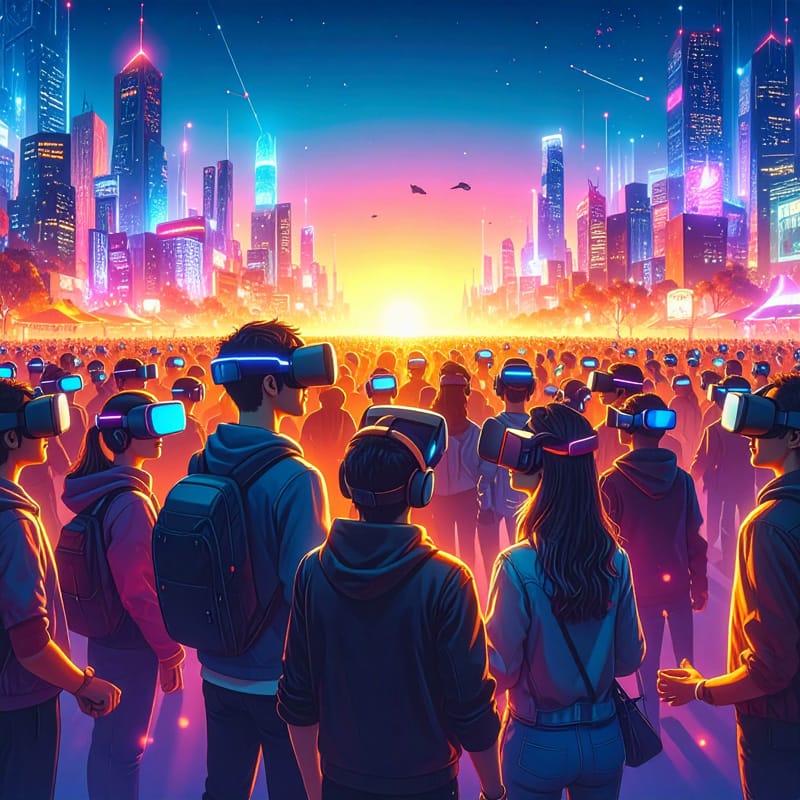The Metaverse promises to transform how we work, play, and connect online. In his influential article, ‘The Seven Rules of the Metaverse‘, Tony Parisi outlines key metaverse rules that would guide the formation of this digital revolution.
How do these rules stack up against the metaverse vision proposed by Meta (formerly Facebook)? Could these rules help accelerate the realization of this vision? After all the hype, you can bet tech lovers eagerly anticipate seeing some aspects of the vision actually forming.
Although Meta’s first attempt at the Metaverse was a flop, the grandiose vision is not dead. In fact, there exist multiple business opportunities in the metaverse which entrepreneurs with a long term outlook may embark on.
So, let’s break down each of these seven rules and explore how they can drive mass user adoption. I hope this post will provide some inspirations for your entrepreneurial ideas.
Rule #1: There is Only One Metaverse
Parisi says the Metaverse should be a single, shared digital space. Meta echoes this statement by aiming to unify social VR, AR, and 3D worlds under one platform.
A single digital realm like the Internet would certainly make digital life less confusing and convenient for the users. Likewise, the connectivity between Web2 and Web3 must be seamless in order to attract the masses of users to get onboard. When companies are able to integrate all the relevant technologies efficiently into a single domain, the Metaverse revolution will come alive.
Imagine a seamless digital realm that is compatible with different types of avatars and digital wallets. Users can then immerse themselves in a massive virtual realm with endless places and things to explore and do.
Rule #2: The Metaverse is for Everyone
Parisi’s rule insists on openness and inclusivity. Meta’s vision however seems to contradict this rule. Being a profit-driven company, we would expect Meta’s to enforce controls that would lock-in users to its own ecosystem.
For a digital space to be truly accessible to everyone, it would need to be accessible to multiple different types of devices. The tools to create 3D contents would also need to be open source, universal and easy to learn.
By making the metaverse feel welcoming and universal, it would attract new segments of users beyond hardcore gamers and techies. Less we forget, the Internet was only able to expand when the general public learnt how to utilize the network.
Rule #3: Nobody Controls the Metaverse Rules
Decentralization will free the Metaverse from authoritarian control. Although Web3 is progressing very slowly now, the industry could expand very rapidly when a disruptor inject a game changer into the industry. For example, just look at how ChatGPT accelerated us into the AI era.
True decentralization builds trust. The trustless system that Bitcoin relies on ensured its survive all these years. Users will invest more time and money when they feel that the platform is not controlled by a single gatekeeper.
Rule #4: The Metaverse is Open
Open source standards like WebXR and glTF can play important roles in connecting different virtual 3D worlds. In order for the Metaverse to be truly accessible, the core protocols that the system utilize must be adaptable to a wide range of software.
Take for example the http standard that millions of web pages rely on throughout the Internet. Without it, we will not be able to view anything online via a wide variety of smart devices.
Open source technologies lowers the barrier for developers, so they can create a wide variety of apps and content. As stated in my previous post titled ‘The Metaverse Vision and Problem’, the lack of compelling content is one of the problems that is hindering the metaverse from becoming fruition. We need the Metaverse to be rich with a wide variety of contents in order to keep users coming back.

Get Ready For Your Future With Free Web3 Metaverse Courses.
Your future has actually already begun, so let’s get started towards career success by enrolling in essential Web3 metaverse courses with Alison. You only pay if you need the certificate and I may get a commission as an affiliate.

The Seven Metaverse Rules That Drive User Adoption
Rule #5: The Metaverse is Hardware Independent
Parisi believes anyone should be able to access the Metaverse from any device. We are so accustomed to having a ubiquitous Internet, thus the Metaverse must also be easily accessible from everywhere.
A hardware-agnostic approach means users can more easily dip their toes into virtual reality (VR). The advent of affordable VR headsets (e.g. Meta Quest and Pico) have brought us one step further into realizing the Metaverse vision.
Another notable device that can accelerate the Metaverse vision is the augmented reality (AR) glass i.e. smart glass e.g. Ray-Ban Meta and XReal One. Higher specs smart glasses can even track the user’s hands, which enhances the immersive experience.
Rule #6: The Metaverse Rules Around a Network
In Parisi’s own words, “The Metaverse is a computer network connecting the world’s publicly accessible virtual experiences, real-time 3D content and related media.” It should be similar to the Internet except that the contents are presented in 3D and able to facilitate communication for wide range of uses.
Meta’s vision leans toward one big platform, but it also explores interconnection with other services and tools. A true network effect will expand the practical usefulness of the Metaverse. In a simple economic sense, the more people join in, the more valuable it will become.
Rule #7: The Metaverse Rules Evolve from the Internet
This rule reminds us the Metaverse isn’t a separate entity distinct from the Internet. Meta aligns closely to this rule, positioning the Metaverse as an extension of its social network roots. By framing it this way, users can feel more familiar with what the Metaverse can offer.
It is of course not realistic to expect hordes of today’s Internet users to suddenly abandon their attachment to flat 2D screens. However, technological and product improvements in smart glasses and VR headsets could boost user adoption rate for the Metaverse.
Change Your World
Advance your entrepreneurial and start up ideas with Stanford University’s free business online courses in partnership with Alison. You only pay if you need the certificate and I may get a commission as an affiliate.
Conclusion: The Metaverse is User Centric
Tony Parisi’s seven rules describe an ideal Metaverse that Internet users will enjoy immersing in. Among the Metaverse’s attractive features are openness, user-driven and seamless connectivity with the current Internet.
Will Meta’s Metaverse vision manifest in the very near future? Perhaps Horizon Worlds was not really a flop but was just meant to be a test pilot to gauge the market’s reaction. If that was the case, then we can certainly expect Meta to launch a real world product soon that could satisfy users’ whims and fancies.
These seven Metaverse rules are nonetheless powerful because they keep the user front and center. Ultimately, the Metaverse must be user centric as the majority of Internet users now are definitely more tech savvy compare to those from previous generations.






